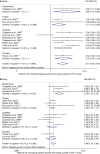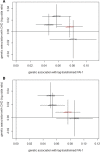Causal Effect of Plasminogen Activator Inhibitor Type 1 on Coronary Heart Disease
- PMID: 28550093
- PMCID: PMC5669150
- DOI: 10.1161/JAHA.116.004918
Causal Effect of Plasminogen Activator Inhibitor Type 1 on Coronary Heart Disease
Abstract
Background: Plasminogen activator inhibitor type 1 (PAI-1) plays an essential role in the fibrinolysis system and thrombosis. Population studies have reported that blood PAI-1 levels are associated with increased risk of coronary heart disease (CHD). However, it is unclear whether the association reflects a causal influence of PAI-1 on CHD risk.
Methods and results: To evaluate the association between PAI-1 and CHD, we applied a 3-step strategy. First, we investigated the observational association between PAI-1 and CHD incidence using a systematic review based on a literature search for PAI-1 and CHD studies. Second, we explored the causal association between PAI-1 and CHD using a Mendelian randomization approach using summary statistics from large genome-wide association studies. Finally, we explored the causal effect of PAI-1 on cardiovascular risk factors including metabolic and subclinical atherosclerosis measures. In the systematic meta-analysis, the highest quantile of blood PAI-1 level was associated with higher CHD risk comparing with the lowest quantile (odds ratio=2.17; 95% CI: 1.53, 3.07) in an age- and sex-adjusted model. The effect size was reduced in studies using a multivariable-adjusted model (odds ratio=1.46; 95% CI: 1.13, 1.88). The Mendelian randomization analyses suggested a causal effect of increased PAI-1 level on CHD risk (odds ratio=1.22 per unit increase of log-transformed PAI-1; 95% CI: 1.01, 1.47). In addition, we also detected a causal effect of PAI-1 on elevating blood glucose and high-density lipoprotein cholesterol.
Conclusions: Our study indicates a causal effect of elevated PAI-1 level on CHD risk, which may be mediated by glucose dysfunction.
Keywords: Mendelian randomization; coronary heart disease; genome‐wide association study; plasminogen activator inhibitor type 1; single nucleotide polymorphism.
© 2017 The Authors. Published on behalf of the American Heart Association, Inc., by Wiley Blackwell.
Figures



Similar articles
-
Exploring the Causal Pathway From Telomere Length to Coronary Heart Disease: A Network Mendelian Randomization Study.Circ Res. 2017 Jul 21;121(3):214-219. doi: 10.1161/CIRCRESAHA.116.310517. Epub 2017 May 17. Circ Res. 2017. PMID: 28515044
-
Exploring the causal pathway from omega-6 levels to coronary heart disease: A network Mendelian randomization study.Nutr Metab Cardiovasc Dis. 2020 Feb 10;30(2):233-240. doi: 10.1016/j.numecd.2019.09.013. Epub 2019 Sep 16. Nutr Metab Cardiovasc Dis. 2020. PMID: 31648883
-
Genetic Association of Waist-to-Hip Ratio With Cardiometabolic Traits, Type 2 Diabetes, and Coronary Heart Disease.JAMA. 2017 Feb 14;317(6):626-634. doi: 10.1001/jama.2016.21042. JAMA. 2017. PMID: 28196256 Free PMC article.
-
Mendelian randomization to assess causal effects of blood lipids on coronary heart disease: lessons from the past and applications to the future.Curr Opin Endocrinol Diabetes Obes. 2016 Apr;23(2):124-30. doi: 10.1097/MED.0000000000000230. Curr Opin Endocrinol Diabetes Obes. 2016. PMID: 26910273 Free PMC article. Review.
-
HDL Cholesterol Metabolism and the Risk of CHD: New Insights from Human Genetics.Curr Cardiol Rep. 2017 Nov 4;19(12):132. doi: 10.1007/s11886-017-0940-0. Curr Cardiol Rep. 2017. PMID: 29103089 Review.
Cited by
-
Causal effects of cardiovascular health on five epigenetic clocks.Clin Epigenetics. 2024 Sep 27;16(1):134. doi: 10.1186/s13148-024-01752-5. Clin Epigenetics. 2024. PMID: 39334501 Free PMC article.
-
Blood PAI-1 and cardiovascular and metabolic risk factors among the middle-aged women from SWAN study.Sci Rep. 2024 Sep 11;14(1):21207. doi: 10.1038/s41598-024-71908-z. Sci Rep. 2024. PMID: 39261530 Free PMC article.
-
Associations of gut microbiota features and circulating metabolites with systemic inflammation in children.BMJ Open Gastroenterol. 2024 Aug 29;11(1):e001470. doi: 10.1136/bmjgast-2024-001470. BMJ Open Gastroenterol. 2024. PMID: 39209769 Free PMC article.
-
A genomic mutational constraint map using variation in 76,156 human genomes.Nature. 2024 Jan;625(7993):92-100. doi: 10.1038/s41586-023-06045-0. Epub 2023 Dec 6. Nature. 2024. PMID: 38057664
-
Mendelian randomization analyses suggest a causal role for circulating GIP and IL-1RA levels in homeostatic model assessment-derived measures of β-cell function and insulin sensitivity in Africans without type 2 diabetes.Genome Med. 2023 Dec 4;15(1):108. doi: 10.1186/s13073-023-01263-7. Genome Med. 2023. PMID: 38049854 Free PMC article.
References
-
- Fay WP, Parker AC, Condrey LR, Shapiro AD. Human plasminogen activator inhibitor‐1 (PAI‐1) deficiency: characterization of a large kindred with a null mutation in the PAI‐1 gene. Blood. 1997;90:204–208. - PubMed
-
- Patrassi GM, Sartori MT, Saggiorato G, Boeri G, Girolami A. Familial thrombophila associated with high levels of plasminogen activator inhibitor. Fibrinolysis. 1992;6:99–103.
-
- Hamsten A, de Faire U, Walldius G, Dahlen G, Szamosi A, Landou C, Blomback M, Wiman B. Plasminogen activator inhibitor in plasma: risk factor for recurrent myocardial infarction. Lancet. 1987;2:3–9. - PubMed
-
- Tissue plasminogen activator for acute ischemic stroke. The National Institute of Neurological Disorders and Stroke rt‐PA Stroke Study Group. N Engl J Med. 1995;333:1581–1587. - PubMed
Publication types
MeSH terms
Substances
Grants and funding
LinkOut - more resources
Full Text Sources
Other Literature Sources
Miscellaneous

